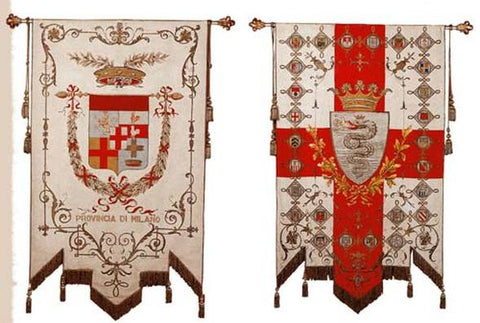
Flags were not only used by the nobility in the Middle Ages, the military used flags bearing regimental colors and in the Catholic Church the position of gonfalonier, or standard-bearer, of the Church, was one of the most prestigious offices the pope could bestow. The office of gonfalonier takes its name from another type of flag popular among city states and other nations during the Middle Ages, the gonfalone (image above). Such flags were often massive in size and bore many tails. They were carried hanging down from a cross beam, like the sail of a ship. Prior to battle the gonfalone was blessed by the clergy and it was considered a great disgrace to lose it as some were considered to have miraculous powers. Because of its size the gonfalone was often carried on a cart, driven by a member of a particular family for whom the post was hereditary. The most famous flag of this type was the Oriflamme of France, which for centuries was kept in the Abbey of St. Denis ( the burial place for the French royal family). The exact appearance is unknown but oral tradition suggests that it was made of red silk with gold trimmings, and it hung from a staff of gilded wood or metal; hence its name which means “golden flame”. Some accounts suggest that the Oriflamme was last seen in use at the Battle of Agincourt in 1415, where its bearer William Martel, Seigneur de Baqueville, lost his life defending it. Other sources suggest that it remained in the Abbey of St. Denis until the 18th century, when it was described as being in a very unkempt state.
There are many countries that use either the Coat of Arms of the land or at least some of the colors of the Arms for the flag. Spain, for example, has the royal arms contained within its national flag. Other countries that contain an image of their national Coat of Arms on the national flag include Slovenia. Mexico and Costa Rica.






